Imagine an exceptionally tender and juicy filet mignon steak seared to golden-brown perfection on a cast iron skillet… Once you try this cooking method, you won’t look back!

What Is Filet Mignon?
Filet mignon is a cut of beef taken from the tenderloin of a cow. This cut is prized for its melt-in-your-mouth texture and delicate flavor, making it one of the most expensive steaks. Because filet mignon is quite lean and contains minimal fat marbling, it’s best not to cook it past medium doneness to preserve its tenderness.
In this recipe, cast iron aids to perfectly caramelize the crust while keeping the inside of the steak juicy. Quick and hot is the name of the filet mignon game — a few minutes per side is all it takes to achieve the best texture and flavor.
Cast Iron Filet Mignon Video
How To Make Cast Iron Filet Mignon
This cast iron filet mignon is the perfect dinner recipe because it takes only 10-15 minutes. Whenever you’re hungry but short on time, pull out a cast iron skillet and get searing!
- Season the steak: Pat the filet mignon steaks dry with a paper towel. Let the steaks rest at room temperature for about an hour, then season generously with salt and pepper.
- Preheat the skillet: Preheat a cast iron skillet on high heat until it’s almost smoking. Drizzle the skillet with oil.
- Cook the steak: Place the filet mignon in the pan. Sear the filet for a few minutes on each side (3-6 minutes) to your preferred level of doneness.
- Serve the steak: Allow the steaks to rest for at least 10 minutes prior to serving, then enjoy!
Flavor tip: Infuse mouthwatering flavor by basting the steak in a couple tablespoons of butter, smashed cloves of garlic, and a handful of fresh herbs (like rosemary, thyme, or bay leaves). Or, top the cooked steak with garlic herb butter for flavor that melts into every bite.
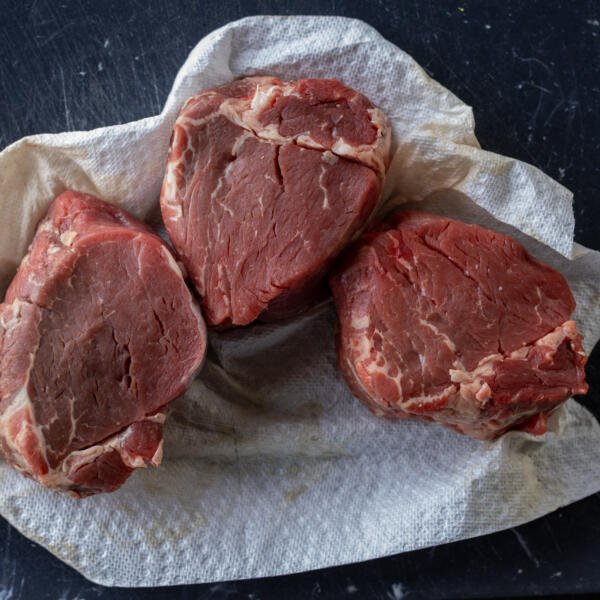
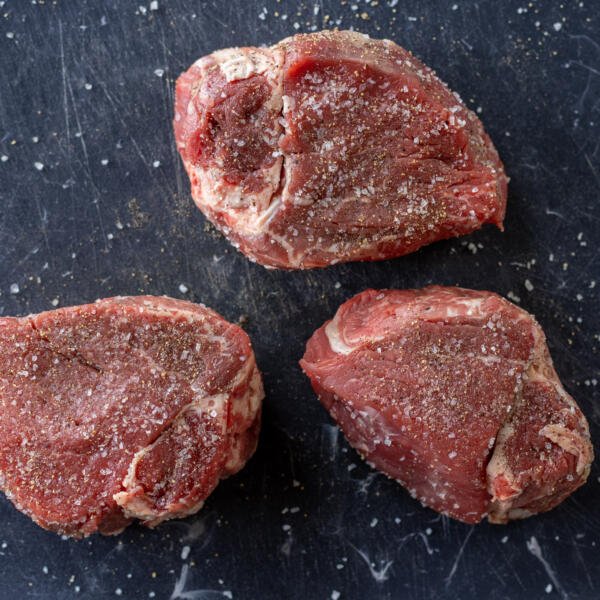
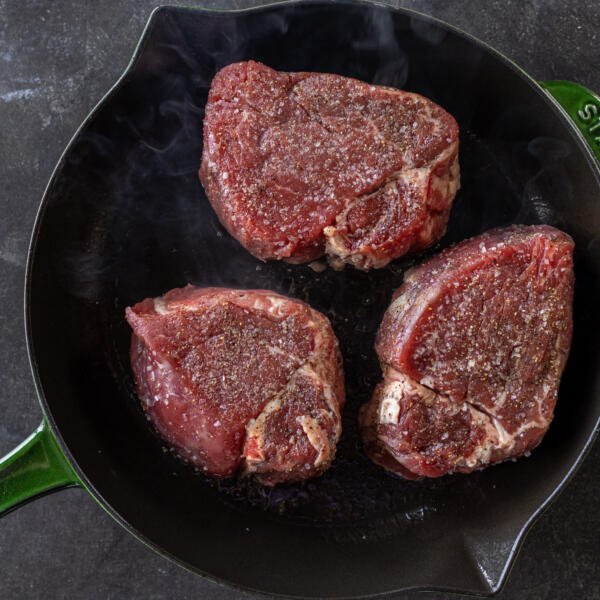
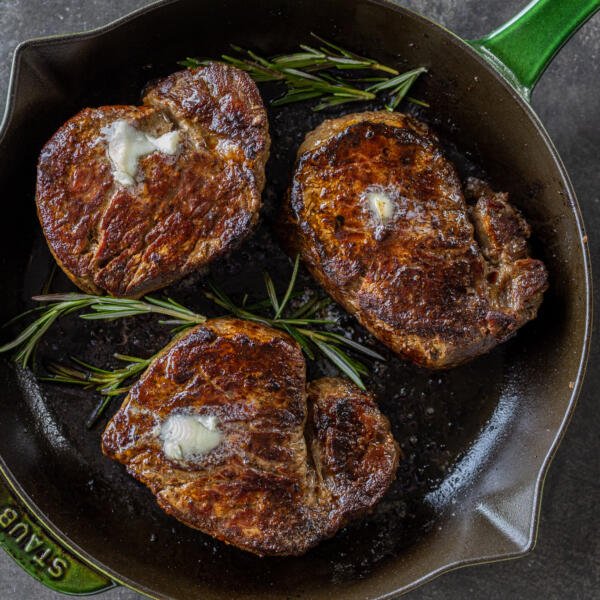
A Guide To Steak Doneness
Whether you like your steak well-done or rare, we’ve got your back. Let’s go through a list of different cooking temperatures to find what best suits your tastes.
- Rare: For a cool, dark red interior, cook your steak to 130-135°F. This is the juiciest and most tender level of doneness — but it’s not for the faint of heart!
- Medium-rare: For a warm, red center, cook your steak to 140°F. Medium-rare is also juicy and tender.
- Medium: For a hot, pink center, cook your steak to 155°F. This is the perfect option for those who still want a tender steak but are wary of too much pink on the inside.
- Medium-well: For a mostly brown interior, cook your steak to 160°F. Medium-well has a tendency to be firm and tough.
- Well-done: For a completely brown interior, cook your steak to 165°F. We don’t recommend cooking steak to well-done because it becomes dry and hard to chew — but we won’t judge if that’s your preference.
Hot tip: Pull the steak off the heat a few degrees shy of your preferred level of doneness. The residual heat will continue to raise the temperature of the steak about five degrees while resting.

Tips For a Perfect Filet Mignon
Filet mignon can be quite pricey, so it’s important to use the right techniques when cooking it. Follow these tips to make a crowd-pleasing, unforgettable filet mignon.
- Choose thick cuts of filet mignon. The steaks should be at least 1.5-2 inches thick to achieve a caramelized crust and juicy interior. Thin steaks are much more susceptible to overcooking.
- Bring the filet to room temperature before cooking it. Room temp steak cooks more evenly and browns faster than cold steak. When cold meat hits a hot pan, the muscle fibers tense up, slowing down the cooking process.
- Pat the steak dry. A dry surface allows the crust to caramelize properly. The more moisture on the steak, the more steam is created when it hits the hot pan, preventing a good sear.
- Preheat the cast iron. Make sure the pan is ripping hot before placing the steak on it — this ensures the steak won’t stick while building a nice golden-brown crust.
- Use a thermometer to gauge doneness. A meat thermometer like this one takes the guesswork out of producing perfectly cooked steak. Take the steak off the heat a few degrees shy of your preferred level of doneness, since the residual heat will continue to cook it.
- Rest the steak before cutting into it. We know you’re eager to dig into your hot filet mignon — but hold off for 5-10 minutes! Cutting into the steak too soon causes the juices to leak out, resulting in a dry texture.
Ways To Serve
Once your filet mignon has cooked and rested, it’s ready to cut into and serve. Pair the steak with your favorite steak sauce for a burst of flavor. If you love a tasty appetizer while your steak finishes cooking, make this lobster bisque. Despite how delicious the steak is on its own, it’s even better with an array of sides! Bring out mashed potatoes, roasted asparagus, and sautéed mushrooms to make everyone’s mouths water. Pair with broiled or grilled lobster tail for the ultimate surf and turf dinner. Then, add more veggie goodness with a classic caesar, an ultimate garden salad or Russian vinaigrette salad. Craving more carbs? You can’t go wrong with homemade dinner rolls … mmm.
Storage & Reheating
If you couldn’t quite manage to devour the entire filet mignon, take these next steps to enjoy it again later. Remember to keep your leftovers cold — food safety is #1!
- Refrigerator: To store for up to four days, transfer the cooked filet mignon to an airtight container and refrigerate.
- Reheating: For the best leftover experience, reheat your steak using the oven-to-pan method. Allow the steak to come to room temperature while you preheat the oven to 250°F. Once it’s preheated, place the steak on a baking sheet and heat for 20-30 minutes. Then, finish the steak off in a hot oiled skillet, searing both sides to restore the crispy crust.
Hot tip: If you can get your hands on one, a vacuum sealer is the best way to package and store leftover steak. The airtight seal preserves the juiciness of the meat and locks in the flavor!
FAQ
What is the best pan for cooking filet mignon?
Cast iron is the best pan to use for cooking filet mignon. It heats evenly and retains an intense amount of heat that is perfect for searing steak.
Should you use butter or oil for cooking filet mignon?
You should use oil with a high smoking point (like avocado oil) to grease the pan when cooking filet mignon, as butter may burn from the high heat. Add butter to the pan in the last few minutes of cooking to baste the steak and infuse flavor.
How do you cook filet mignon in a cast iron without it sticking?
The key to preventing filet mignon from sticking to cast iron is to grease and preheat the pan properly. Heat the pan until it’s nearly smoking, then add enough oil to lightly coat the surface. Do not move the steak until it develops a caramelized crust.
More Steak Recipes
- Grilled Ribeye Steak — Tender and juicy ribeye cooked on the grill
- Steak Sandwich — Steak strips piled high on a buttery baguette with caramelized onions and cheese
- Air Fryer Steak Bites — Chunks of steak and mushrooms cooked to perfection in the air fryer
- Steak Fajitas — Seasoned steak strips tossed with sautéed peppers and onions
Recipe
Ingredients
- 2 lbs Filet mignon steaks 1 1/2- 2 inch thickness
- 2 tbsp kosher salt adjust to taste
- 1 tbsp ground black pepper adjust to taste
- 1 tbsp oil
Instructions
- Pat the filet mignon steaks dry with a paper towel. Let the steaks rest at room temperature for about an hour.
- Season generously with salt and pepper
- Preheat a cast iron skillet on high heat until it's almost smoking. Drizzle the skillet with oil. Place the filet mignon in the pan.
- Let the filet cook for a few minutes on each side (3-6 minutes) to your preferred level of doneness, refer to the temperature guide above.
- Allow the steaks to rest for at least 10 minutes prior to serving. Enjoy!
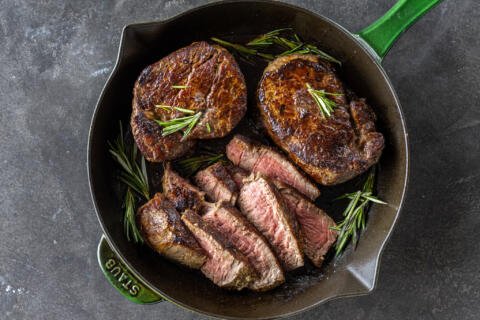



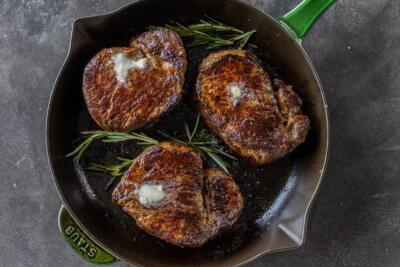

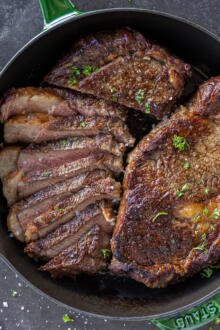

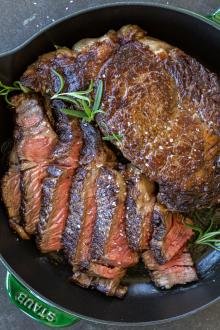
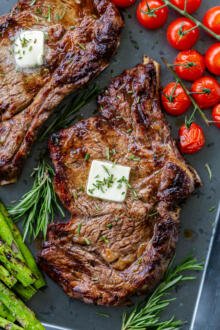

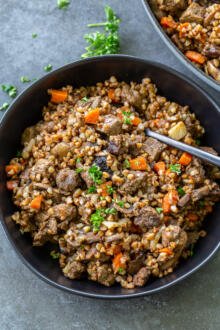
No Comments